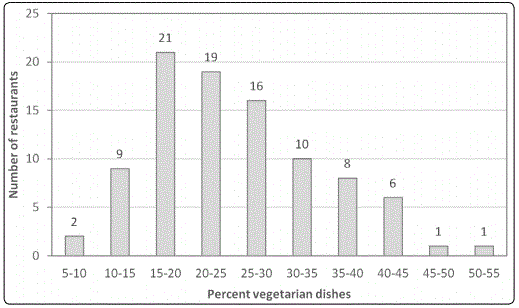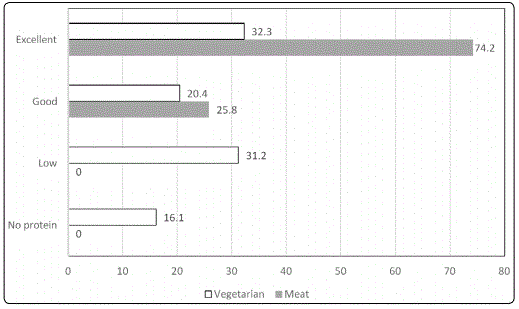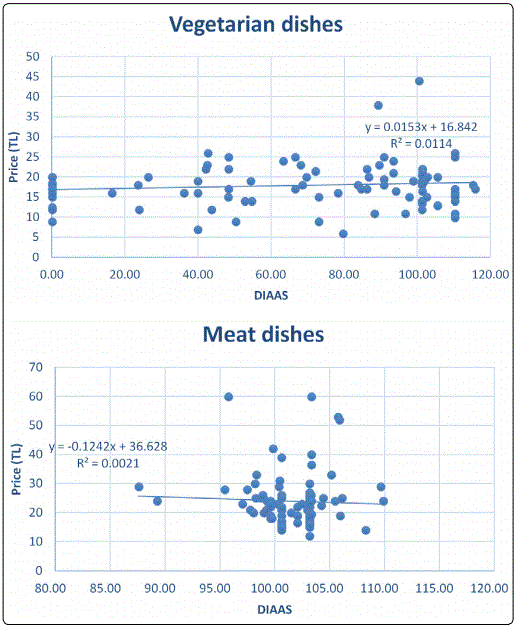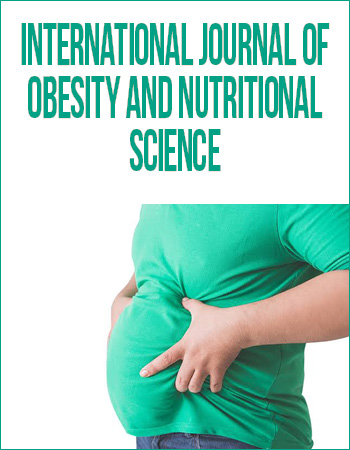Research Article
Approximation of Protein Quality (DIAAS) of Vegetarian Dishes Served in Restaurants
1UKVRN Registered Nutritionist, United Kingdom
2Department of Gastronomy and Culinary Arts, School of Applied Sciences, Ozyegin University, Istanbul, Turkey
*Corresponding author: Ayten Aylin Tas, UKVRN Registered Nutritionist, United Kingdom, E-mail: atas@lincoln.ac.uk
Received: February 6, 2019 Accepted: March 14, 2019 Published: March 21, 2019
Citation: Tas AA, Umit N, Alkan RO, Boynak A, Yeral SD. Approximation of Protein Quality (DIAAS) of Vegetarian Dishes Served in Restaurants. Int J Obes Nutr Sci. 2019; 1(1): 1-5. doi: 10.18689/ijons-1000101
Copyright: © 2019 The Author(s). This work is licensed under a Creative Commons Attribution 4.0 International License, which permits unrestricted use, distribution, and reproduction in any medium, provided the original work is properly cited.
Abstract
Protein quality (DIAAS) of the most popular vegetarian and meat dishes served by 93 restaurants was calculated using published data on the digestibility of individual amino acids. Protein qualities of the vegetarian dishes were found to be lower than the meat dishes. A considerable number of vegetarian dishes (16.1%) did not contain any proteinaceous ingredient and therefore received a DIAAS value of zero. Meat dishes did not contain any low quality protein and their DIAAS values were higher than 87%. Vegetarian dishes only comprised 15 to 30% of the total number of dishes in most restaurants (60.2%). Pasta (21.5%), vegetable dishes (such as boiled, grilled or sautéed vegetables) (20.4%) and salads (19.4%) were found to be the most-selling vegetarian dishes. Price of the dishes, whether they were vegetarian or not, did not relate to the protein quality of the dishes.
Keywords: Protein quality; DIAAS; Vegetarian dishes; Restaurant; Amino acids.
Introduction
Vegetarians, who refrain from eating the flesh of animals, usually make up a small fraction of populations. In the UK, the number of vegetarians is estimated to be nearly 2% of the population [1]. In the USA, this number reaches to 3.3% with the inclusion of vegans [2]. Receiving adequate amounts of high quality protein is a major concern for people wishing to become a vegetarian. Nutrition authorities, however, continue to emphasize that a well-planned and balanced diet is able to achieve the protein needs of vegetarians [3].
The prevalence of eating out is increasing, as is the range of eating outlets and types of food [4] but this still does not ascertain vegetarians to be able to consume healthy and well-balanced meals every time they eat out. The variety of vegetarian dishes that are nutritionally adequate is quite limited when compared to the vast number of choices a meat-eater can make. The limited repertoire of vegetarian choices includes pasta, pizza, sandwiches and salads, which are prepared by mainly utilizing vegetables, cereals, legumes, nuts and sometimes seeds. Combining these ingredients and configuring a dish containing protein of good or high quality is not always the priority of the restaurants, whose aim is to continue to exist as a business entity and earn profit. Secondly, offering vegetarian dishes with good or high quality protein also necessitates catering staff with sufficient nutritional knowledge.
Protein quality of foods is the ability of dietary protein to supply the amino acid needs of the body. High protein content may not always correspond to high content of digestible indispensable amino acids (IAAs) [5]. Protein quality of a food is determined according to the amino acid (AA) content of the food and its protein digestibility. In 2013, Food and Agriculture Organization of the United Nations (FAO) recommended the digestible indispensable amino acid score (DIAAS) method to replace the protein digestibility-corrected amino acid score (PDCAAS) for evaluating protein quality [6]. DIAAS utilises individual amino acid digestibility determined at ileum and therefore eliminates the confounding effect of the catabolism and synthesis of AAs by the hindgut microflora on faecal measurements [7]. DIAAS method does not include truncating of scores and therefore it recognises the excess value of amino acids such as dairy proteins. It also takes into account the variation in the amino acid reference pattern of different age groups (i.e. children and adults) [6].
In an era where eating out is on the increase and meat consumption is on the headlines because of sustainability issues, this study aims to raise awareness of vegetarianism and the nutritional needs of vegetarian people by drawing attention to the limited choices of vegetarian dishes served in restaurants. The study attempts to approximate the protein quality of vegetarian dishes by calculating their DIAAS values. It also compares the protein quality of vegetarian and meat dishes and investigates whether protein quality is associated with the price of the dishes.
Materials and Methods
Choice of restaurants
The restaurants included in the study offered at least two vegetarian main courses in their menus. The restaurants were located in the neighbourhood of Caferaga and part of Osmanaga (Kadikoy, Istanbul, Turkey). The neighbourhoods were chosen due to their central location and easy accessibility by public transport.
Fast food chains and restaurants that offered only one type of meal such as pizza were not included in the study. A total of 110 restaurants were visited and data was collected from 93 of them. Nine restaurants declined to take part and eight restaurants were under refurbishment at the time of the study.
Menu and recipe analysis Menus and recipes were analysed in consultation with the chefs in the restaurants. During the visits to the restaurants through March and April 2017 researchers:
1. Made a note of recipes of best-selling vegetarian and meat dishes and their ingredients.
2. Tasted and examined the dishes when recipe information provided was inaccurate or lacking details.
3. Recorded the price of the dishes.
Nutritional analysis
Protein and indispensable amino acid (IAA) content: The ingredients and their amounts in the recipe of each dish were worked out using the recipe information provided by the chefs. When this information was not available, the researchers studied the recipes by tasting the dishes and weighing the ingredients. Protein and IAA content of the dishes were obtained from a food composition database (BeBIS, Ebispro for Windows, Version BeBiS 7, Pasifik Company) that contained information on 20,000 foods and beverages. The USDA Food Composition Database was used for a few foods that BeBiS did not contain the details of.
Protein quality: Protein quality (DIAAS) of the dishes was calculated (Equation 1) using food composition databases (for protein and IAA content) and published data on the digestibility of IAAs (histidine, isoleucine, leucine, methionine, phenylalanine, threonine, tryptophan and valine). After the DIAAS value for each IAA available in the food is computed, the lowest value is assigned as the DIAAS score (as percent) for that food. If a calculation was made for a mixed dish (i.e. recipes incorporating more than one ingredient that contain protein), the values above 100 were not truncated to 100. Protein quality was classified as excellent (for DIAAS values equal to or greater than 100, good (DIAAS values between 75 and 99) and low (DIAAS values less than 75) [6].

For the reference scoring patterns of IAAs, the values for adults (aged 18 or over) were used (Table 1). This group better represented the individuals that consumed vegetarian dishes in the restaurants.
Only the ingredients with a protein content higher than 2.5% were included in the calculations. This was because the ingredients with low protein content did not make a significant contribution to the DIAAS values.
The true ileal digestibility (TID) values were obtained from published data [8-12].
Statistical analysis
Microsoft Office Excel was used to calculate the DIAAS values and explore the possible relationship between the protein quality and the prices of vegetarian and meat dishes.

His: Histidine; Ile: Isoleucine; Leu: Leucine; Lys: Lysine; SAA: Sulphur Amino Acids (methionine+cysteine); AAA: Aromatic Amino Acids; Thr: Threonine; Trp: Tryptophan; Val: Valine.
*For methionine and phenylalanine, SAA and AAA values were used, respectively.
Results
Most popular vegetarian and meat dishes
Pasta (21.5%), various vegetable dishes (such as boiled, grilled or sautéed vegetables) (20.4%) and salads (19.4%) were the most-selling vegetarian dishes. Among the meat dishes, burgers (29.0%), chicken (24.7%) and meatballs (12.0%) were the most popular (data not shown).
In most restaurants (60.2%) vegetarian dishes comprised 15 to 30% of the total dishes. Fewer restaurants offered vegetarian dishes that made up more than 30% of the menu. Only one restaurant had 50-55% of their dishes vegetarian (Figure 1).

Protein quality of vegetarian and meat dishes
A total of 15 vegetarian dishes (16.1%) did not contain any proteinaceous ingredient and therefore received a DIAAS value of zero (Figure 2). The protein in 31.2% of the vegetarian dishes were found to be of low quality (DIAAS value<75%). This ‘low’ quality can be attributed to the deficiency of sulphur amino acids (methionine in particular) in beans and legumes and that of lysine in cereals [5]. The following beans and legumes were used in the vegetarian dishes (in the order of most frequently used to least): chickpeas, lentils, broad beans, black-eyed beans and mung beans. The most commonly used cereal in the vegetarian dishes was wheat, which was followed by bulgur and rice.

The proteins in 20.4% of the vegetarian dishes were of good quality and 32.3% of them were excellent quality. The dishes with excellent protein quality included at least one dairy product (i.e. different types of cheese and yogurt). This confirmed once more the ability of milk proteins to complement the lower quality protein sources, which is important particularly in providing opportunities for sustainable diets [13]. The use of eggs -which is another sustainable source of protein- in the recipes also contributed to better protein quality in the vegetarian dishes.
Meat dishes (n=93) did not contain any low quality protein and their DIAAS values were higher than 87%. Slightly, more than a quarter (25.8%) of the meat dishes was identified as containing good quality proteins and 74.2% of the dishes contained excellent quality proteins. The main ingredient in the meat dishes was beef followed by chicken, turkey, sausages, pastrami and lamb. Fish, although identified as containing protein of ‘excellent’ quality (DIAAS>100%) [14], was not part of any of the meat dishes.
Protein quality and price of vegetarian versus meat dishes
There was no linear relationship between the protein quality and price of neither vegetarian nor meat dishes. The correlation coefficients for vegetarian and meat dishes were r=0.11 and r=0.05, respectively (Figure 3).

Discussion
Among the indispensable amino acids, methionine, lysine, tryptophan and threonine concentrations are reported to be generally lower in plant-based sources of proteins [15]. The first-limiting amino acid (LAA) in the vegetarian dishes was methionine (69.9%), followed by lysine (8.6%) and phenylalanine (5.4%). Phenylalanine was found to be the first-limiting amino acid in most (93.5%) meat dishes followed by methionine (6.5%) (Data not shown). Pseudo cereals (quinoa, buckwheat and amaranth), which are abundant in leucine and phenylalanine, are excellent sources of AAs [16]. Among 93 vegetarian dishes, only one was found to utilize quinoa and another one contained buckwheat as a source of protein. This could be due to higher costs of these pseudo cereals as they are not cultivated in many parts of the world [17].
The improved amino acid profile of mixtures of foods containing protein, in comparison with profiles of single foods, is known as ‘complementation’ [18]. None of the vegetarian dishes in the study made use of this concept by combining two protein sources with complementary amino acid profile. The following foods can be paired to form complementary proteins: Legumes with grains, nuts and seeds; grains with legumes; vegetables with grains, nuts and seeds; corn with legumes. Bean and rice or tortillas, tofu with rice (or any grain), hummus with pitta bread, lentil soup with bread, quinoa salad with black beans are few examples for dishes whose proteins complement each other. By the inclusion of these foods/ingredients, the protein quality of vegetarian dishes can be significantly improved.
Because plant-based foods provide less protein per gram of food, greater quantities of plant-based sources of protein would need to be consumed to achieve the same total protein intake [19]. Conversely, the portion size of most meat dishes was found to be greater than vegetarian dishes in the current study.
Vegetarians, when dining out in non-vegetarian restaurants, are reported to have a limited and non-creative variety of meatless options (e.g. salad and pastas) [20] and this was also the case in the current study. Restaurants consider the retail prices, costs and the effort of staff in the kitchen when it comes to designing new dishes. With respect to the growing trend towards healthy food choices, menu planning also becomes more complicated due to associated activities for searching and selecting new ingredients and creating healthy menu options [21].
Obviously, there are other reasons that derive from consumers` perceptions and these can influence the menu decisions of restaurants. In most places around the world, the consumption of meat is held in high esteem and meat is regarded as a food product with high nutritional value [22]. It is also a common misconception among consumers that vegetarian food is boring, unsatisfying and uninspiring. Many chefs and cooks that cater to vegetarians think that preparing and delivering quality vegetarian meals is hard work [23]. Nevertheless, none of these seems to be a justifiable reason to produce vegetarian dishes of low protein quality or dishes that contain no protein at all.
This study raises some worrying concerns as to the attentiveness of restaurants to the needs of the vegetarians. It is hoped that the study would contribute to drawing the attention of food service professionals to the importance of the protein content/quality of vegetarian dishes offered in restaurants. As ever, nutritional knowledge of culinary staff remains an important factor influencing the food choices of individuals when dining. There should be continuous effort to provide culinary staff appropriate training in order to offer healthier, more varied and nutritionally-balanced dishes/meals to the public, especially to the people whose diets lack one or more of food groups. Restaurants can also utilize their vegetarian friendly options to address other important trends in the food industry such as sustainable protein consumption and environmental impact of our daily food choices.
Conclusion
One of the challenges in the study was that the TID values (for protein and/or IAAs) could not be found for all ingredients. In cases where the TID values obtained from human studies were unavailable, values obtained with the growing pig (the preferred animal model) or the growing rat were sought for. When the latter was non-existent, then AA digestibility was assumed to be equivalent to crude protein digestibility, as stipulated by the FAO [6]. Another approach taken due to lack of the TID data was to assume similar values for comparable ingredients (i.e. instead of cheese, the TID value of casein was used). When doing this, protein content, cooking technique and/ or botanical family of the ingredient were taken into account. This study corroborated once more the need for developing studies and gathering data on ileal AA digestibility directly determined in humans [10].
Among the dishes examined, vegetarian dishes had considerably lower protein quality than non-vegetarian ones. Some vegetarian dishes did not contain any protein at all. Although all menus that were examined included at least one vegetarian dish, the menus were predominantly comprised of meat dishes. The price of the dishes, whether they were vegetarian or not, did not relate to the protein quality. Vegetarian menu options in the restaurants were limited and the protein quality of approximately 47% of vegetarian dishes was unsatisfactory.
The study lays emphasis on the need for increasing the awareness of foodservice industry of the needs of vegetarian people. Restaurants should endeavour to provide vegetarian menus with greater diversity and offer dishes with better protein quality and higher nutrient density. The motives and nutritional needs of vegetarians should be recognised and actualised during the process of menu development. This is a preliminary study and further studies that look into protein quality of dishes offered to people with other dietary requirements (i.e. vegan and different types of vegetarianism such as lacto and pesco vegetarianism) are needed.
Conflict of Interest
No conflict of interest was reported by the authors.
Funding
This research did not receive any specific grant from funding agencies in the public, commercial or not-for-profit sectors.
References
- Bates B, Lennox A, Bates C, Swan G. National Diet and Nutrition Survey. Department of Health and Food Standards Agency. 2012.
- The Vegetarian Research Group. How many adults in the U.S. are vegetarian and vegan? 2016.
- Melina V, Craig W, Levin S. Position of the Academy of Nutrition and Dietetics: Vegetarian diets. J Acad Nutr Diet. 2016; 116(12): 1970–1980. doi: 10.1016/j.jand.2016.09.025
- Edwards JSA. The foodservice industry: Eating out is more than just a meal. Food Qual Prefer. 2013; 27(2): 223–229. doi: 10.1016/j.foodqual.2012.02.003
- McGuire M, Beerman KA. Nutritional Sciences from Fundamentals to Food. 3rd edition. Belmont, USA: Wadsworth Cengage Learning. 2011.
- FAO. Dietary protein quality evaluation in human nutrition. Report of an FAO expert consultation. Food and Nutrition Paper 92. Rome Italy: Food and Agriculture Organization of the United Nations. 2013.
- Wolfe RR, Rutherfurd SM, Kim IY, Moughan PJ. Protein quality as determined by the Digestible Indispensable Amino Acid Score: Evaluation of factors underlying the calculation. Nutr Rev. 2016; 74(9): 584–599. doi: 10.1093/nutrit/nuw022
- Boye J, Wijesinha-Bettoni R, Burlingame B. Protein quality evaluation twenty years after the introduction of the protein digestibility corrected amino acid score method. Br J Nutr. 2012; 108: S183–S211. doi: 10.1017/S0007114512002309
- FAO. Protein quality evaluation report of Joint FAO/WHO Expert Consultation. Food and Nutrition Paper 51. Rome Italy. Food and Agriculture Organization of the United Nations. 1989.
- Moughan PJ, Gilani S, Rutherfurd SM, Tome D. True ileal amino acid digestibility coefficients for application in the calculation of Digestible Indispensable Amino Acid Score (DIAAS) in human nutrition. Report of a Sub-Committee of the 2011 FAO Consultation on “Protein Quality Evaluation in Human Nutrition” on: The assessment of amino acid digestibility in foods for humans and including a collation of published ileal amino acid digestibility data for human foods. 2012: 1–58.
- Petersen GI, Smiricky-Tjardes MR, Stein HH. Apparent and standardized ileal digestibility of amino acids in gelatin-based diets by growing pigs. Anim Feed Sci Technol. 2005; 119(1-2): 107–115. doi: 10.1016/j.anifeedsci.2004.11.006
- Rutherfurd SM, Bains K, Moughan PJ. Available lysine and digestible amino acid contents of proteinaceous foods of India. Br J Nutr. 2012; 108: S59–S68. doi: 10.1017/S0007114512002280
- Leser S. The 2013 FAO report on dietary protein quality evaluation in human nutrition: Recommendations and implications. Nutr Bull. 2013; 38(4): 421–428. doi: 10.1111/nbu.12063
- Shaheen N, Islam S, Munmun S, Mohiduzzaman M, Longvah T. Amino acid profiles and digestible indispensable amino acid scores of proteins from the prioritized key foods in Bangladesh. Food Chem. 2016; 213: 83–89. doi: 10.1016/j.foodchem.2016.06.057
- Chardigny JM, Walrand S. Plant protein for food: Opportunities and bottlenecks. OCL. 2016; 23(4): 1–6.
- Mota C, Santos M, Mauro R, et al. Protein content and amino acids profile of pseudocereals. Food Chem. 2016; 193: 55–61. doi: 10.1016/j.foodchem.2014.11.043
- Alvarez-Jubete L, Arendt EK, Gallagher E. Nutritive value of pseudocereals and their increasing use as functional gluten-free ingredients. Trends Food Sci Technol. 2010; 21(2): 106–113. doi: 10.1016/j.tifs.2009.10.014
- Phillips F. Vegetarian nutrition - briefing paper. British Nutrition Foundation. 2005; 30: 132–167.
- Richter CK, Skulas-Ray AC, Champagne CM, Kris-Etherton PM. Plant protein and animal proteins: Do they differentially affect cardiovascular disease risk? Adv Nutr. 2015; 6(6): 712–728. doi: 10.3945/an.115.009654
- Shani A, DiPietro RB. Vegetarians: A typology for foodservice menu development. Hospitality Review. 2007; 25(2): 66–73.
- Ozdemir B, Caliskan O. A review of literature on restaurant menus: Specifying the managerial issues. Int J Gastron Food Sci. 2014; 2: 3–13. doi: 10.1016/j.ijgfs.2013.12.001
- Bohrer MB. Review: Nutrient density and nutritional value of meat products and non-meat foods high in protein. Trends Food Sci Technol. 2017; 65: 103–112.
- Rivera M, Shani A. Attitudes and orientation toward vegetarian food in the restaurant industry - An operator`s perspective. International Journal of Contemporary Hospitality Management. 2013; 25(7): 1049–1065.


